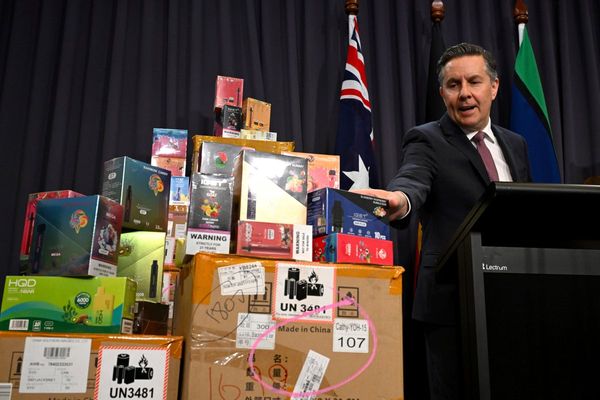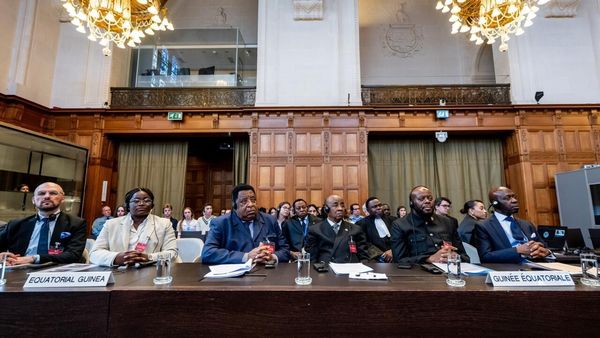(Bloomberg Businessweek) -- Chary Wright knows that for bigger women, shopping for clothes can be rough. Until a few years ago, some mainstream retailers didn’t carry anything larger than a size 12. Stores that did might have stocked only one or two pieces. Or maybe they had plenty but just put out the extra smalls, smalls, and mediums, requiring anyone who needed a different size to ask an always-slender saleswoman, a living, breathing reminder that fashion is for thin people. Wright has spent 18 years making shopping fun for plus-size women. At an Ashley Stewart in a New Jersey shopping plaza, she sells clothes in sizes 12 to 26. She listens to customers who sometimes feel bad about their bodies and, like many women who work in Ashley Stewart Inc.’s shops, plays the role of stylish sister-friend.
“I hear it all the time: ‘I’m too fat. I’m ugly,’ ” says Wright, an area manager. The youngest and chubbiest of 14 cousins, she grew up with an ex-model for a mother, a woman who insisted that Wright focus on school, be kind to senior citizens, and sit up straight. The day I meet Wright, she’s wearing a ruffled orange blouse, and her short hair has longish bangs tipped in gold. “I make her look in the mirror. I’ll sit her in her underwear and her bra and say, ‘Look at you. You are gorgeous. Own your beauty.’ ”
It’s hard to imagine having that experience at the Gap. But little about Ashley Stewart is typical of the low-wage, high-turnover retail industry. The company is committed to its stores, which are located almost exclusively in low- to middle-income urban areas. Wright’s East Orange, N.J., neighbors include a barbershop, a Dunkin’ Donuts, a 24-hour supermarket, and elevated commuter train tracks. Its most loyal customers are overweight black women, a group that fashion usually ignores twice over.
“You know—‘You can never be too rich or too thin.’ And historically, black women haven’t been the picture of either”
The most surprising thing about Ashley Stewart is that Ashley Stewart still exists. The company filed for Chapter 11 in 2010, and four years later it filed once more. “To have failed again so soon is a really bad sign,” says Steve Warren, a bankruptcy lawyer at O’Melveny & Myers LLP, who represented Clearlake Capital, the private equity company in Santa Monica, Calif., that bought Ashley Stewart out of bankruptcy in 2014. “Clearlake had a lot of interest and faith in James.”
James Rhee had agreed to spend six months starting in late 2013 at Ashley Stewart headquarters in Secaucus, N.J., leading the company through its second bankruptcy. The private equity investor, now 46, knew the business: In 2010, while running a retail turnaround fund for Gordon Brothers Group LLC in Boston, he’d bought the company for his portfolio. What Rhee told Clearlake was that successful Ashley Stewart locations were community fixtures. Regular customers might stop in three times a week because being there made them feel good about themselves. Even though Ashley Stewart isn’t a real person—the name is a 1990s-era homage to Laura Ashley and Martha Stewart—she’s as real to customers as Oprah: a person-slash-brand, relatable across class and color. “My wife is African American. In some respects, I identified as much as anyone with this company,” says Clearlake founder and managing partner José Feliciano. Rhee says, “This is a company of contradictions—I’m a Korean kid from Long Island, and I’m Ashley Stewart.”
Joseph Sitt, then a 24-year-old real estate investor, founded Ashley Stewart in 1991. Struggling to find tenants for commercial properties he owned in New York’s black neighborhoods, he created one. “They didn’t get the same service, the same quality of stores,” he says. “Our goal was to cater to the needs of African American women.” Sitt thought the name would evoke refinement. “My lawyers told me I was going to get sued,” he says. (He didn’t.) Sitt opened his first store in downtown Brooklyn, a second in Harlem, and a third in Newark, N.J. The floors were pink marble, the walls mahogany. Security guards wore tuxedos. Customers got a red rose.
Over the next 19 years, the company expanded, adding a brand for Latina women and one for kids. Sitt got out in 2000, and the management changed again and again until it wound up with Rhee and Gordon Brothers in 2010.
As a teenager in suburban New York, Rhee finished at the top of his class and went to Harvard. He was stunned by his classmates’ wealth. “I didn’t know anything about money,” he says. “Going to Harvard was like going to Mars.” Rhee studied American and English history and literature, graduating with honors. He took a job teaching history at a private school outside Springfield, Mass. Two years later he returned to Cambridge for law school. After getting his degree, he went into finance.
Evaluating Ashley Stewart in 2010, Rhee says he saw a company with a bloated management structure hampered by underperforming sister brands. He identified a customer who reminded him of his mom: someone who would do anything for her family, who deserved the respect of strangers but rarely got it. This person would be loyal to brands that treated her well. Led by Rhee, Gordon Brothers bought Ashley Stewart out of bankruptcy for about $32 million, a deal that shed the other brands and legacy liabilities. He helped hire an executive team and, until he left Gordon Brothers in 2012 to open his own investment shop, watched as the company looked at itself in the mirror and started to believe that maybe it was gorgeous, too.
But the retailer couldn’t catch a break. Hurricane Sandy disrupted business before the 2012 holidays. Its technological infrastructure was crumbling. Gordon Brothers put it back up for sale. A year after he’d left, Rhee says he got a call: The board wanted him to take over as interim chief executive officer and stave off liquidation. With his wife’s blessing, Rhee rented an apartment not far from headquarters. She and the kids stayed in Boston, and he saw them on weekends.
Rhee says he felt obligated to employees, lenders, vendors, and shareholders: “I felt I was right about this brand as an investor.” People close to him say his motivation was also personal: “He wanted to go in there and prove—probably more to himself—that he didn’t make a mistake” when he bought the company the first time, says Steven Chang, who championed the deal for Clearlake. “He’s got three school-aged children. For him to be on the road four or five days a week, he really wanted to do this.”
When Rhee arrived in Secaucus, he found a roach-infested warehouse and outdated technology. The stressed-out management team was barely on speaking terms. Rhee called the employees together for a town hall and introduced himself (as an investor at Gordon Brothers, he hadn’t been involved in day-to-day operations), telling them he might be the least qualified person to lead Ashley Stewart. His retail experience consisted of a $3.35-per-hour stint at a Red Lobster in the mid-1980s. He asked for help.
What happened next plays like a movie montage. Rhee sold scrap metal to make payroll, worked alongside employees until 2 a.m. to renegotiate vendor contracts, begged creditors for more time, and moved headquarters to a cheaper space. With liquidation on the horizon, Rhee gave the 40 best-performing stores $250 each to donate to charity and threw a holiday party at the YWCA in Brooklyn. “I came to that evening a pretty broken guy,” Rhee confessed to a raucous crowd this fall at another party in Brooklyn, this time at the Kings Theatre, to celebrate Ashley Stewart’s 25th anniversary. “I felt like we had failed.” And yet he’d put on a Santa hat and, after a night of dancing with employees and the Y’s mostly homeless invitees, redoubled his resolve. “This ragtag bunch of people,” he told the Kings Theatre gathering, “we pulled off a miracle.”
Retail is just catching up with Ashley Stewart. This fall, Nanette Lepore introduced a line that goes up to size 24, and new labels such as Eloquii, Universal Standard, and ASOS Curve have come online, displaying outfits on bigger bodies—back fat, dimpled knees, and all. There’s a business rationale. The average American woman weighs 168 pounds and wears a size 14 or 16. That’s not generally reflected in mainstream media, though Sports Illustrated put size-16 model Ashley Graham on the cover of its swimsuit issue in 2016.
Most of the time, in the world as fashion magazines represent it, overweight women are shrouded in a cloak of invisibility. Large black women are erased. “People in fashion argue that they sell a dream, and an aspirational image, and traditionally that image has been a rich-looking, blonde, blue-eyed woman,” says Elizabeth Wissinger, a professor of fashion studies at City University of New York and author of This Year’s Model: Fashion, Media, and the Making of Glamour. “You know—‘You can never be too rich or too thin.’ And historically, black women haven’t been the picture of either.”
Black women are likely to be plus-size—about 80 percent are overweight or obese, according to Trust for America’s Health and the Robert Wood Johnson Foundation—but they also feel confident about their bodies. A 2012 Washington Post/Kaiser Family Foundation poll finds that 66 percent of overweight black women say they have high self-esteem compared with 41 percent of average-size or thin white women. Chastity Garner Valentine, a fashion blogger and co-founder of plus-size style convention TheCurvyCon, grew up with a black father and white mother. “I got to see a lot of the differences between the way that weight is treated,” she says. “I love my mama dearly, but I was on diets since I was 11. She was concerned about my health, but also my appearance and how people would receive me. Around my black family, I didn’t feel pressure to be a smaller woman.” Wright, the Ashley Stewart manager, says, “I know the struggle. But once you love your body and own it, it’s not a controlling factor in your life.”
A lot of plus-size fashion has assumed that bigger women aren’t proud of their physiques. Not Ashley Stewart. The clothes are form-fitting and a little dramatic. Even basics aren’t basic. Pencil skirts come in bold colors and patterns (knee-length pinstripe, $45); tunics have strategic cutouts that are sexy without being too revealing (plaid and floral print, $40); and ruffles on sleeves, hems, and jackets proliferate (peplum leather jacket, $70). Cleavage is accentuated. Skin is exposed. “We don’t sit around asking, ‘What does a size 22 want to wear to her daughter’s graduation?’ ” company President Kristen Gaskins tells me. “We ask, ‘What’s in fashion?’ Your size is irrelevant. Our girl likes her shoulders, she likes her boobs, she likes her butt.” Then Gaskins corrects herself: “No, she loves her butt.”
Before Ashley Stewart filed for its second bankruptcy in 2014—shortly after Rhee took over—he reached out to Clearlake’s Chang. They liked weird deals and shared a perfectionist’s reluctance to admit failure. Rhee suggested they work together. Clearlake bought the company’s assets for $18 million and added operating capital to the balance sheet. After the deal closed, Rhee invested $5 million of his own.
With Gordon Brothers’ investment wiped out, a postmortem ensued. In Rhee’s mind, Ashley Stewart had been run too conventionally. It needed reinvention, but getting the day-to-day operations team to see that was challenging. “That’s a hard thing to do, to convince the best people in the world to join a company that was not viewed as a particularly prestigious opportunity,” he says. Rhee had little sympathy for career executives—people he’d installed during his time at Gordon Brothers—who didn’t show sufficient passion in Secaucus. For their part, they felt belittled and betrayed, according to current and former employees. “A second bankruptcy could have been avoided,” says Celia Clancy, Ashley Stewart’s CEO from 2011 to 2013. “It hurt a lot of people.”
With new capital from Clearlake, Rhee cut 40 percent of corporate head count and closed 44 percent of the stores—primarily in malls to get out of onerous rent deals. They upgraded the internet in shops and equipped sales associates with iPads to show customers the company’s website and Facebook page.
Today, Ashley Stewart, with 89 stores, is still a fraction of the size of Lane Bryant, the biggest and best-known plus-size brand in the U.S., with 764 locations. But according to company data, Ashley Stewarts are more productive, with sales per square foot rising faster than Lane Bryant and bucking the broader retail trend.
It’s also thriving online, where sizes run to 32 and sales are up almost fourfold since 2013, accounting for about 40 percent of total revenue—money that’s used to support the brick-and-mortar enterprise. Black women make up about 80 percent of Ashley Stewart’s in-person customers but only 50 percent of its online audience.
The ownership saga at Ashley Stewart has yet another plot twist. About a year ago, Clearlake put it up for sale. Chang had left the company, which was finally making money, and investors were ready to exit. It found a buyer in Invus Group LLC, an investment vehicle for Belgian sugar billionaire Eric Wittouck. A little more than two years after it emerged from Chapter 11, Ashley Stewart was sold for more than $140 million, a roughly sixfold return in less than three years.
Now there are a lot of happy tears at Ashley Stewart. At least two longtime employees get choked up when they try to articulate what the company’s success means to them. Walking through the office the day after the 25th anniversary party, Rhee, who agreed to stay on as CEO after the Invus purchase, wants to know if a photo editor had gotten teary-eyed at the party. “Did you cry?” he asks. (She did.)
The company gives out eight quarterly “CEO citizenship” awards to store associates, a national recognition that comes with a $1,500 spot bonus. Phyllis Stewart, a district manager, says: “Retail is tough. There are a lot of things you don’t control. You might not meet your targets. You might not get your bonus. This says, ‘We appreciate you.’ ” Stewart started at the company in its original Newark location in the mid-’90s, a year before her mom died. “She knew I had people who would be my family,” she says. Her co-workers attended the funeral en masse.
Rhee sees an eclectic future for the brand. Recently the company’s YouTube channel, AshleyTV, topped 400,000 subscribers; programming is a mix of style tips, recipes, and corporate self-promotion. It’s developing marketing and distribution deals with beauty and hair-care brands that could feature in-store mini-salons. Rhee is planning to tell Ashley Stewart’s story at a handful of predominantly black colleges to promote the business and its customers. And the company will reprise Finding Ashley, its nationwide pageant to identify “the diva that effortlessly personifies Ashley Stewart.”
“The events and the cosmetics and the education, they have more to do with the person than the clothes,” he says. “I hope it’ll have ancillary benefits for clothes selling, but I want Ashley Stewart to become a hub of activity, the same way our stores are a hub of activity in the community. I’m trying to replicate that as a business model.” Rhee is investing in retail locations in Hampton, Va., Chicago, Nashville, and Miami.
The first time I went to an Ashley Stewart, it was with Gaskins, the company president, to the newly opened Newark location. I wear a size 14, which makes me one of the smallest customers in a plus-size store and on the bigger end of “straight-sized” retail. Like plenty of women my size and bigger, I shop reluctantly and dress semi-apologetically. I didn’t wear a bikini until I was well into my 30s. I’ve given up jewelry entirely.
At Ashley Stewart, as I took detailed journalistic notes about the tailored skirts and long fall dusters on display, I found myself distracted by a sense of relief. Gaskins pointed out small details as we walked around the store, including the jewelry, which is made in bigger proportions. An Ashley Stewart customer likes a necklace chunky and her earrings big, Gaskins said. Most jewelry will never create the drama she wants, “and we want to be considerate of her in every way,” she added. I wrote that in my notebook and felt as if I were about to cry.
To contact the author of this story: Janet Paskin in New York at jpaskin@bloomberg.net.
To contact the editor responsible for this story: Bret Begun at bbegun@bloomberg.net, Miranda Purves
©2017 Bloomberg L.P.







